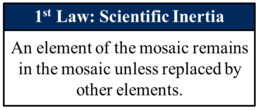Mechanism of Scientific Inertia for Methods
What makes the methods of an agent's mosaic continue to remain in the mosaic?
It is important to specify the conditions under which an employed method stays employed.
In the scientonomic context, this question was first formulated by Hakob Barseghyan in 2015. The question is currently accepted as a legitimate topic for discussion by Scientonomy community.
In Scientonomy, the accepted answers to the question can be summarized as follows:
- An employed method remains employed unless replaced by other methods.
- An element of the mosaic remains in the mosaic unless replaced by other elements.
- An accepted theory remains accepted unless replaced by other theories.
Contents
Scientonomic History
Acceptance Record
| Community | Accepted From | Acceptance Indicators | Still Accepted | Accepted Until | Rejection Indicators |
|---|---|---|---|---|---|
| Scientonomy | 1 January 2016 | This is when the community accepted its first answer to the question, The First Law for Methods (Barseghyan-2015), which indicates that the questions is itself considered legitimate. | Yes |
All Theories
| Theory | Formulation | Formulated In |
|---|---|---|
| The First Law for Methods (Barseghyan-2015) | An employed method remains employed unless replaced by other methods. | 2015 |
If an answer to this question is missing, please click here to add it.
Accepted Theories
| Community | Theory | Accepted From | Accepted Until |
|---|---|---|---|
| Scientonomy | The First Law for Methods (Barseghyan-2015) | 1 January 2016 |
Suggested Modifications
Current View
In Scientonomy, the accepted answers to the question are The First Law for Methods (Barseghyan-2015), The First Law (Barseghyan-2015) and The First Law for Theories (Barseghyan-2015).
The First Law for Methods (Barseghyan-2015) states: "An employed method remains employed unless replaced by other methods."
Formulated for methods, the first law states that the implicit expectations employed in theory assessment will continue to be employed until they are replaced by some alternate expectations. Just as is the case for The First Law for Theories (Barseghyan-2015), this law does not impose limitations on the sort of methods that can replace employed methods.1p. 125 However, importantly, "the community never remains with no expectations whatsoever. When facing a new theory, the community always has some implicit expectations concerning such theories. These expectations may be very specific or they may be very abstract and vague, but some expectations are always present, for otherwise no theory assessment would be possible."1p. 126
Mechanism of Scientific Inertia for Epistemic Elements
The First Law (Barseghyan-2015) states: "An element of the mosaic remains in the mosaic unless replaced by other elements."
The following passage from The Laws of Scientific Change summarizes the gist of the law:
According to the first law, any element of the mosaic of accepted theories and employed methods remains in the mosaic except insofar as it is overthrown by another element or elements. Basically, the law assumes that there is certain inertia in the scientific mosaic: once in the mosaic, elements remain in the mosaic until they get replaced by other elements. It is reasonable therefore to call it the law of scientific inertia.1p. 123
Mechanism of Scientific Inertia for Theories
The First Law for Theories (Barseghyan-2015) states: "An accepted theory remains accepted unless replaced by other theories."
According to this formulation of the first law for theories, an accepted theory remains accepted unless replaced by other theories, even though sometimes that replacement may simply be the negation of the theory. That is, "if for some reason scientists of a particular field stop pursuing new theories, the last accepted theory will safely continue to maintain its position in the mosaic," with no further confirmation of the theory required.1p. 122 There is no specification of what sort of theory might replace an accepted theory. Barseghyan notes that, in the most minimal case, a theory may simply be replaced by its own negation.1p. 122
Related Topics
This question is a subquestion of Mechanism of Scientific Inertia for Normative Theories.


